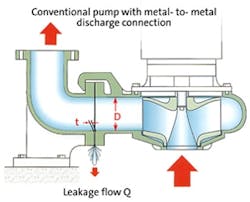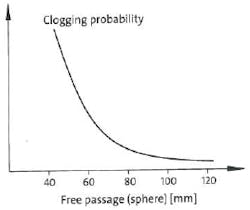Improving lifecycle costs for wastewater pumps
Lifecycle cost calculations in wastewater installations can realise huge savings over time for the wastewater company. The lifecycle costs summarise the total cost of a wastewater installation – and in this regard the pump system plays a major role. Lars Bo Andersen, global product manager for Grundfos Wastewater provides advice and addresses the launch of a single-channel impeller to prevent clogging.
The pump system may not be the largest single investment in the wastewater installation, but over the time from cradle to grave it is the component in the system that is the key element to ensure long-term cost-effectiveness of the wastewater installation.
Total lifetime costs normally include costs such as planning, design, purchasing, installation, commissioning, energy, maintenance and operation, downtime costs and of course any environmental costs and costs for disposal at the end of the lifetime. Most of these costs are however rather insignificant parts of the lifecycle costs of a wastewater installation and only three of these factors have significance. This article therefore focuses only on the pump system, since this will normally have the highest impact on the total cradle-to-grave, lifetime cost of the wastewater installation.
In the pump system, the three main issues that need to be considered are, depending on the pump brand selected and in no particular order:
- Investment
- Energy costs
- Maintenance costs
Investment
The initial procurement cost is often seen by municipalities and contractors as the parameter to ensure low cost. Meeting investment budgets means keeping in mind that the cost of operation, maintenance and disposal could be five to 20 times higher than the initial investment. This is why municipalities and contractors increasingly consider the requirements for performance, reliability and energy consumption when purchasing a pump system.
Choosing the right pump is therefore a key issue which needs to be handled carefully – not by looking only at the initial procurement costs but by looking at the total lifecycle cost. This means other people besides the purchaser, for example a service maintenance engineer and designer, should be involved in the decision of the pump purchase, to ensure pump system reliability.
Energy costs
Decision makers might think that the energy cost of the pump is easy thing to work out. You simply take a pump catalogue, find the correct pump for the wastewater installation, look at the curve and determine the energy consumption in the specified duty point. Then you multiply with the estimated running hours, price per kW and the expected lifetime of the pump – and you have the total energy cost of the pump over the lifetime.
Well, think again – many things must be considered when determining the energy cost of a pump. For example:
- Wear
- Variable load
- Installation
- Clogging
a. Wear
A wastewater pump has probably one of the toughest pump jobs in the world. These pumps are pumping media containing sand, stones, rags, robes, beer cans, diapers, and much more. The media content leads to wear and costly breakdown of the pump – if chosen wrongly. The wear of the pump leads to lower efficiency. It has been demonstrated that wear can easily lower the efficiency with 3-5% every year if nothing is done to maintain the pump.
Most pump brands make it possible to restore some of the efficiency loss by different means. Some have a replaceable wear ring, whereas others have built in trimming, where restoration of the efficiency is done by adjustment of the impeller clearance using outside bolts. Even though you might be able to restore some of the efficiency, full restoration of the efficiency is not possible, since the wear affects also non-replaceable parts of the pump.
Considering this, the design of the pump impeller is a key issue, since a simple design with large free passage, no inserts and moving parts will wear less than the opposite, thus ensuring a high efficiency over the pump lifetime.
b. Variable load
The second issue regarding energy consumption is the duty point at which the pump is operating. It is seldom constant and varies depending on the time of the day, over the year and during the pump lifetime. Choosing a pump with a high efficiency in one point might make good business sense at the time of selection, but might be totally wrong later on. Always ask for flat efficiency curves – this ensures high efficiency over a wide duty range and also if the pump is running with variable speed drive.
If the pump is running with variable speed, a pump with a duty point relatively to the right of the curve should be selected so that when adjusting the speed downwards, the pump’s duty point moves to a part of the curve with higher efficiency.
The energy saved when operating with a variable speed drive is also very dependant on the system curve. If the static head is small compared to the friction losses, the energy-saving potential is relatively small; whereas in a system with large friction losses compared to the static head, the savings potential is quite large.
A variable speed drive can also heavily influence the clogging frequency of the pump, as the water velocity might fall below the self-cleaning velocities in the system, as discussed below.
c. Installation
The third issue of energy cost is the installation. It is of course important to avoid leakages in the system and it is recommended to have seals or gaskets at all joints. If the connection between the pump and the installation equipment is metal to metal, leakages can occur, especially when the system gets older. The more leakages there are, the greater the loss of energy.
A too small diameter in the rising main leads to increased head requirements and increased energy consumption, since the pipe friction losses of the installation is amplified in small pipes. A small rising main also increases the leakage flow.
To avoid high losses, the water velocity through the pipes should be kept low. The exact maximum velocity depends on the length and roughness of the pipes. As a rule of thumb the velocity should not exceed 3 m/sec. It is however also crucial to avoid velocities that are too low, as this will result in sedimentation and deposits in the pipes, increasing friction losses and energy consumption. A low velocity will also contribute to the maintenance costs, as manual pipe cleaning might become necessary.
For horizontal rising mains, a minimum of 0.7 m/s is recommended, whereas a vertical rising main should be dimensioned for a velocity of no less than 1 m/s. This is especially important in pump systems with variable operation. The water velocity is of course also heavily influenced by the use of variable speed drives. Care should be taken that the pump is not at all times running at a low speed, as the self-cleaning velocity in the pipes might otherwise not be achieved.
d. Clogging
Clogging in the installation is not connected directly to the energy cost. However the impeller design is and the improved non-clogging capability of an impeller has normally been achieved by using semi-open impeller designs. By using a semi-open impeller, you might gain better non-clogging capabilities, but at the expense of efficiency loss
New developments with impellers now combine the best of both worlds by having non-clogging, high efficiency impellers with large free passage, no inserts and no moving parts. So you get non-clogging and high efficiency without compromising either of them, especially when taking into account the ever-changing dry matter content of modern wastewater.
Why accept clogging problems?
So when it comes to the bottom line customers have learned to accept clogging problems from time-to-time; that is, they have learnt to live with this compromise. But why is this the case? Why do customers need to compromise in order to have a safe and reliable pump operation?
The free spherical passage through a wastewater pump is one of the key determinants for the likelihood of clogging incidents to occur. That is, the greater unrestricted free spherical passage a wastewater pump can allow the LESS risk you have for clogging.
To illustrate the above, try to picture a piece of pipe with the same inner diameter all the way through. If the pipe is straight and has the same inner diameter, you would agree that what goes in – in one end - is likely to come out of the other. There is simply nothing to block the media under way, no disturbances, and no dead zones in the flow.
However, if the pipe on the other hand features a reduction piece, sharp bends or similar, then what comes in is not that likely to come out the other end. This is precisely the situation for impellers and pumps.
The simplicity of a smooth pipe is actually what has created the foundation of the new S-tube impeller used in Grundfos wastewater pumps. This is a high-efficiency impeller with a patented sealing system. The S-tube impeller is shaped as a smooth and hydraulically optimised pipe that nestles the wastewater through the pump; from inlet to outlet – all without compromise. And on top of that the S-tube impeller offers you unmatched hydraulic efficiencies.
www.grundfos.com/no-compromise



